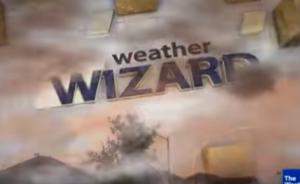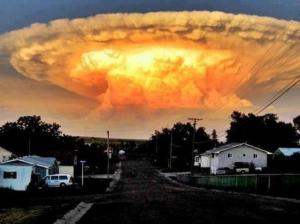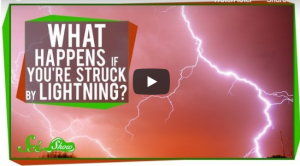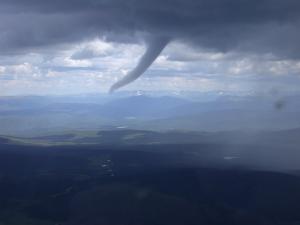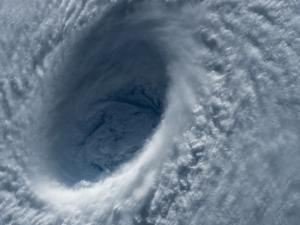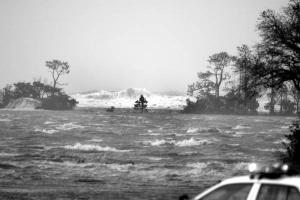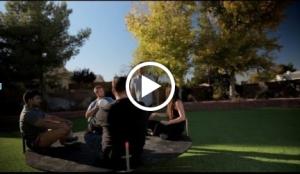Thunderstorms
Daily Dose of Destruction
Thunderstorms produce heavy rains, lightning, thunder, and hail. Thunderstorms are created where cold fronts run into warm moist air causing a low-pressure system, creating columns of warm moist air that rise high into the atmosphere creating some very awesome cloud formations, most of the time as cumulonimbus clouds or thunderheads. As water vapor condensates it forms water droplets that start to bond one with another until raindrops are formed. As rain falls it pushes air creating strong downdrafts.
|
|
As the warm air rises it also creates updrafts dragging rain droplets high into the cloud where the temperatures dip below freezing causing the raindrops to freeze into hail. As hail falls back through the cloud it can gather more moisture and then get caught in another updraft causing the hail to go through the process multiple times forming very large hailstones.
This rapid uplift of air can also build up electric charges of static electricity. The tops of the clouds become positively charged and the bottom of clouds can become negatively charged. Electrical currents can flow between them creating lightning flashes. The ground tends to also be positively charged causing lightning to leave the cloud and strike the ground.
Lightning can reach temperatures of 3000 degrees C which is five times the temperature of the sun. This rapid heating of the air around a bolt of lightning causes the air to expand quickly, then cool, and then contract causing air molecules to move back and forth forming sound waves. We call these sound waves thunder.
This information causes one to ask, "What happens to the human body when it gets hit by lightning? Below is a video that discusses what lightning does to the human body.
Section 2: Tornadoes
First let's complete a lab that helps us take a look at where tornadoes happen, how big are deadly tornadoes, and how frequent are really big tornadoes.
If you are a student at Snowflake, Holbrook, or Heber click here to access the SUSD5 student version of the Tornado Statistic Project Digital lab
You can purchase this Tornado Statistic Project at Teachers Pay Teachers for $1.00.
Severe thunderstorms can produce tornadoes. Tornadoes move along cold fronts. It is important to understand that wind at different heights blows in different directions and at different speeds. The difference in wind direction and speed is called wind shear. Strong updrafts in the storm will tilt the wind shear and produce rotation inside the thunderstorm forming a funnel cloud. Not all funnel clouds reach the ground.
Tornadoes take on the color of the debris. If a tornado moves over water, with will form a water spout and create a clear or white tornado. If it moves through dirt it will become darker brown. If there is a lot of hail in the tornado it might turn a little green.
Wind speeds can reach about 500 km/hour or just over 300 mph. Tornadoes are usually smaller than 200m in diameter but can reach over a mile in width. The United States gets about 700 tornadoes each year.
Tornadoes are measured using the Fujita scale and are based on observed damage. This damage is representative of wind speed.
| F0 | 65-85 mph | Light damage. Breaks tree branches, might know over shallow-rooted trees. Some damage to road signs may occur. |
| F1 | 86-110 mph | Moderate damage. Roofs are damaged, and mobile homes and trailers can be blown over or destroyed. Can blow cars off the side of the road. |
| F2 | 111-135 mph | Considerable damage. The actual roof can be blown off. Mobile homes are not likely to survive. Larger trees are uprooted. Debris becomes very dangerous. Cars can be thrown into the air. |
| F3 | 136-165 mph | Severe damage. Walls start to be torn off of buildings. Trains have been known to be derailed. Trees are uprooted. Larger vehicles are now thrown into the air. |
| F4 | 166-200 mph | Devastating damage. Best of the best-constructed houses are removed from the foundations, and structures with weak foundations can be lifted up and moved. Cars are now thrown like missiles. |
| F5 | >200 mph | Incredible damage. Not much survives. Cars have been known to be thrown to fly over a football field in distance. Trees that survive are stripped bare. |
Section 3: Hurricanes
Before we begin let's start off with a lab.
If you are a student at Snowflake, Holbrook, or Heber click here to access the SUSD5 student Tracking Hurricanes Lab.
You can purchase the Hurricane Tracking Lab at Teachers Pay Teachers for $1.00.
Hurricanes start off as low-pressure systems that form over tropical oceans near Africa. Heat energy is turned into wind. As the wind moves over the warm ocean water it picks up moisture. when a low-pressure system reaches the Northeast trade winds it begins to rotate counterclockwise in the Northern hemisphere. As the warm moist air rises, it begins to cool and condenses forming very thick clouds. These bands of thick clouds form what is called the eye. Inside the hurricane's eye are calm winds. Sea birds have been known to fly in the eye of the storm.
In order to be classified as a hurricane, sustained winds need to become 120 km/h or 74 mph. These high winds cause storm surges which cause massive flooding. Storm surges can rise to about 15 feet and when combined with a tide, storm tide, they can rise to about 20 feet.
Hurricane Categories
| Category | Sustained Winds | Types of damage |
| 1 | 74-95 mph | Damage to roofs, siding, and gutters. branches of trees can be snapped. Shallow-rooted trees topple. Power line damage. |
| 2 | 96-110 mph | Well-built homes can be damaged, roof and siding are very damaged. Shallow-rooted trees uprooted. Power loss is expected. |
| 3 | 111-129 mph | Well-built homes are damaged. Trees are snapped or uprooted blocking roads. Electricity and water are lacking. |
| 4 | 130-156 mph | Most houses will be severely damaged. Most trees are uprooted. Many power poles are tipped over. Severe damage to the electrical grid. |
| 5 | > 157 mph | Most homes are completely destroyed. Most of the power grid is downed. The area is uninhabitable for weeks. |
In the northern hemisphere, hurricanes tend to travel west and then head northeast. You can see the paths of all recorded hurricanes in the image below. Hurricanes slow down and die as they leave warm ocean water and move over land due to the added build-up of friction.
Hurricanes in the northern hemisphere rotate counterclockwise and in the southern hemisphere rotate clockwise, due to the Coriolis effect. The Coriolis force is an apparent deflection of the path of an object that moves within a rotating system. Consider the following two videos.










